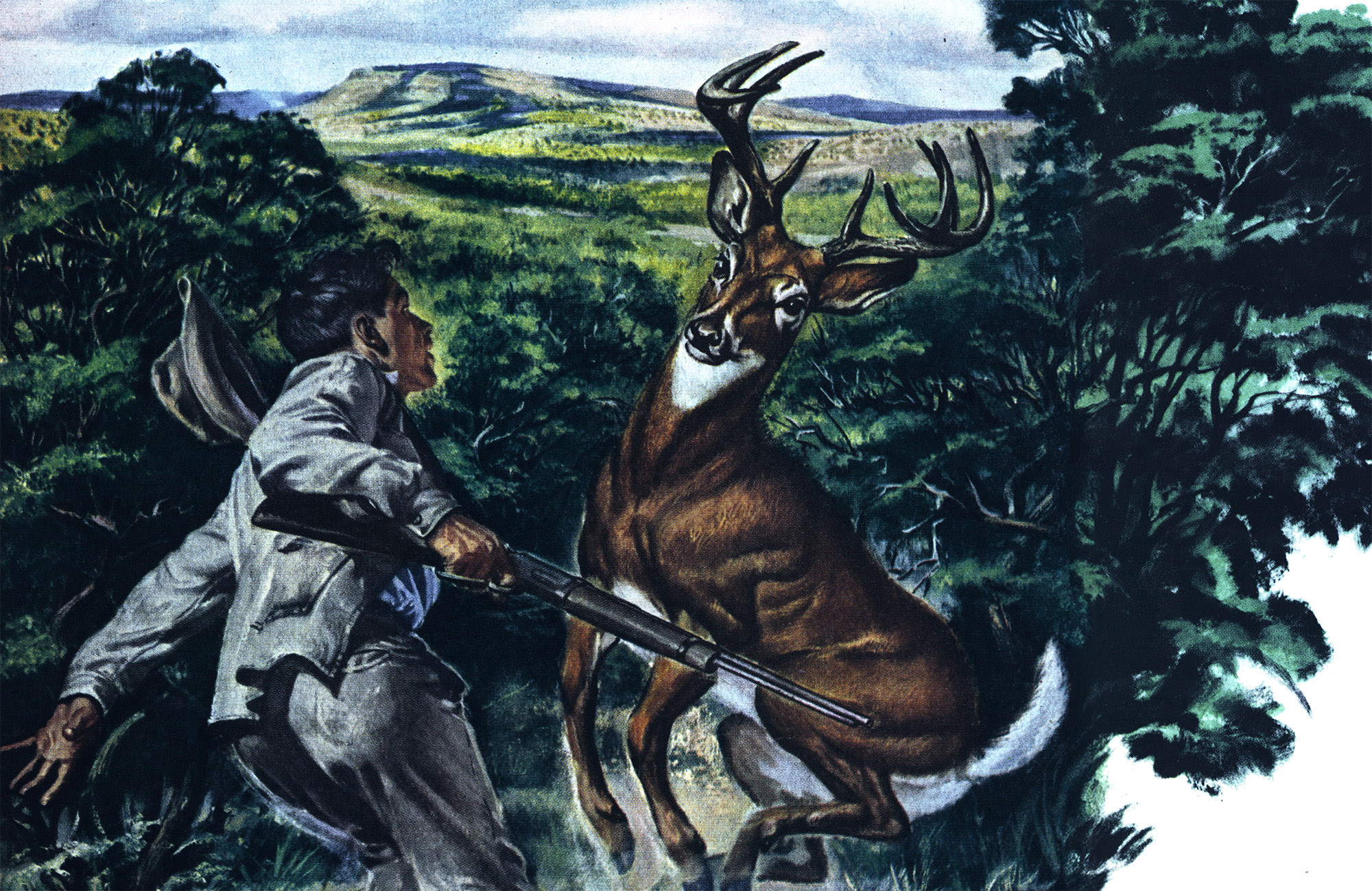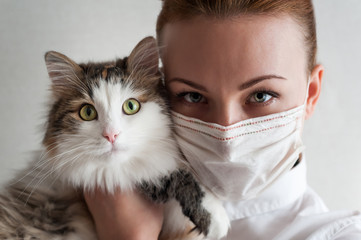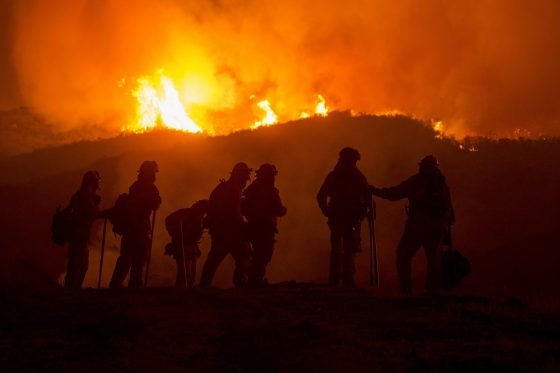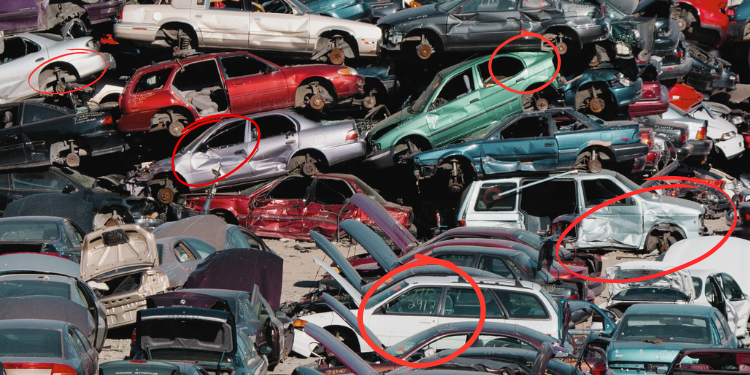Looks That Kill: Using a Deer’s Curiosity to Your Advantage

The old saying that curiosity killed a cat was probably based on an actual occurrence. The idea of the saying is enforced by an Arabian proverb: “He who peeps in at his neighbor’ window may chance to lose his eyes.”
Some animals seem to understand the weakness of curiosity in other animals. A Texas rancher west of the Pecos River told me of seeing a young buck moving out of curiosity toward the swaying tail of a panther hidden in glass. In Mexico I have heard several circumstantial accounts of colts and fillies being drawn toward a hidden panther by sight of its tail waving in tall grass. All this may be folklore; I don’t know. I do know that hunters, both white and Indian, used to entice antelope within shooting distance by lying in grass and waving a foot, a gun, a handkerchief, or some other object.
Deer, specifically white-tail deer, are not o curious in that way as antelope, but if a deer sees something it can’t make out, it often inclines to investigate the thing by sight or smell. Young deer have more idle curiosity than mature ones. An experienced buck suspects danger in nearly any unusual sight, sound, or smell and does not have to get an eyeful, or noseful, before hiding. For him, anything that makes him curious is a proven danger and needs investigation.
Still, there is no absolute rule of this sort about deer. A deer knows when it is hidden. and many a time a wary buck, after putting him elf out of sight, stops to look, smell, and listen.
One day while hunting on horseback in a favored spot, I startled two bucks in scattered brush near a deep arroyo. Th y ran down a trail crossing, and I supposed they went on into a thicket on the other side. I should have dismounted and crept forward afoot. I rode on. When I reached a bend in the trail I saw them standing on the far bank, heads bent back for a glimpse of the noise-making mounted horse that they no doubt had heard following them. They got their clear view and were gone in the same instant — but probably only a short distance away. Aroused deer don’t usually run out of the country; all they are after is a hiding place.
After World War I, I went to manage the big Olmos Ranch then owned by my uncle Jim Dobie down in the brush country of lower Texas. It is located on the Nueces River and was the best deer country I have ever been in. While just riding around, it was not uncommon to count over 100 deer in one day, often with very few bucks in the count. At that time the custom on some big ranches in the brush country was to feed venison to the vaqueros (Mexican cowboys) a good part of the year. We had a hunter attached to the outfit.
Not more than 40 steps from the carcass, I was walking along a narrow deer trail through thick, high brush when that second buck and I met face to face. We could have shaken hands had either of us been inclined.
Along in October I kept seeing a pair of bucks nearly every time I passed a certain dirt tank in the San Casimero Pasture trap. I drove an old T-model Ford without any top. One day before I started out, the cook at the ranch house told me we needed meat. I knew that on the way home I was going to pass by the tank where I had been seeing the pair of bucks, and thought I might get one. I did see them, but they saw me first and galloped off into the brush of a small hill maybe 200 yards away. I felt sure that they would not go far. I got out of the car, took my .30/30, and with the wind in my favor, circled through low, scattered brush to where I could see the far side of the hill. There, about 100 yards away, stood one of the bucks. I did not think about the other one. I am a poor shot, but I broke his neck. He was a heavy 10-pointer and packed lots of tallow. After gutting him, I picked up my rifle and started back to the car to drive it as near as I could to the carcass.
I took a direct route back to the car instead of walking in the circuit I had made away from it. The second buck had passed out of my mind. Not more than 40 steps from the carcass, I was walking along a narrow deer trail through thick, high brush when that second buck and I met face to face. We could have shaken hands had either of us been inclined. We were that close together. We were both too surprised to express any sort of greeting. I certainly had not been looking for any sort of encounter, and evidently the buck hadn’t either.
In turning around in the narrow passage, he stumbled and literally fell over himself. Two or three steps behind him the brush was sparser, not more than breast-high, and mingled with prickly pear. Scared is no word to define his condition of fright — but he did not know exactly what had scared him. His curiosity, mixed with masculine fighting spirit, was so strong that he was not going to leave without satisfying himself on what had scared him. He wheeled, facing me, not more than 12 feet beyond. While he was tumbling over himself getting away, I had advanced two or three steps, and my movement, I suppose, was unseen by him. I could almost have counted the hairs of his eyelashes.
Every long hair on his back was standing up. He was fat, like his mate. Like his mate also, he had 10 points on heavy-beamed, widespread antlers. He was snorting, and the wind was coming out of his lungs with such force that it quivered the black chaparral leaves in front of him. He lowered his head a little and raised it. He was planted on the ground like a cow pony squatting down to hold a roped steer. His instinct was to charge, for he was still not quite sure of what had scared him.
Now I stood transfixed in wonder, gazing at him while he gazed at me. However, I was not making any breathing sounds, as he was. I had my rifle leveled on him, ready to shoot in case he charged. I did not want to shoot. It was a hot day. I had all the meat that headquarters had any use for. We didn’t stand like that more than two or three minutes, I suppose. I don’t 1·emember whether I made a warning noise or not. Anyhow, the fine buck at last understood that the thing which had scared him and which now faced him was the deadly enemy of all deerkind. He wheeled, and in a second was out of sight.
This past season a young friend of mine. out to get his first buck, took a stand up a runty mesquite tree. He had been impressed with the advice that a deer always comes from where you don’t expect him. His position was so cramped that he could not keep watch in all directions, but he managed to scan the area pretty well. except the ground immediately behind him. After a while he felt one of his feet going to sleep and moved it. When he did, a fine buck jumped from right under him and ran out in clear view. He was not ready and supposed he had lost his chance. But this buck, evidently, had neither seen nor smelled the thing he had heard. He stopped off about 75 yards to look back and get the wind on whatever it was. He was behind enough brush to be well hidden from a man on the ground at the tree, but the hunter was not on the ground. He had plenty of time to aim. His “luck” was afforded by the buck’s misplaced curiosity.
Many a hunter who can give instance after instance of curiosity on the part of does and yearlings can’t give a single example — from personal experience of a buck’s curiosity. Part of the fun of hunting the wise-beyond-curiosity bucks is observing the behavior of curious stock deer.
One winter day I was hunting in Uvalde County, Texas, with a Mexican boy trailing me to help carry in the bag if I killed something. A soft drizzle set in-ideal hunting weather — and about noon we came back to the car with wet, cold feet and an appetite for coffee. I drove a short distance on a dim road and then stopped under a live-oak tree on a hillside. We soon had a fire going, the damp wood giving off a heavy, pleasantly odoriferous smoke.
While we squatted, drinking coffee and eating, I saw two yearling deer coming up the hill. (It’s odd how we call a six-month-old fawn a yearling; a calf at that age is still a calf.) I warned the Mexican boy not to move. The yearlings had not seen us, I think, but only the smoke; they probably had smelled it. They came slowly, stopping often, their curiosity increasing. The stationary car was to them merely a part of the landscape. Finally they got so close that I could have chunked one with a stick of wood. They wanted to find out what that curling smoke was. It is the nature of all deer to distrust anything strange; it is the nature of young deer to investigate it.
At late evening one December day on the Olmos Ranch I was riding horseback In a fine mist that cut visibility down to a low point. I was on a big sorrel, a hard-mouthed horse we called Pilon because he had been thrown in as a “pilon” (something extra) with a herd of steers recently purchased. Nearly all yearling deer had cut off from the does and were bunched together, as is their habit in good deer country. While I was approaching the wide salt-grass flat that spreads out on both sides of the Nueces Rivel in this part of southern Texas, I saw two or three yearlings in bush mesquites on the edge of the flat.
I saw them before they saw me, and reined Pilon to a halt. One of the yearlings must have sighted me just as I stopped. It moved forward to see what that looming object in the mist might be. The move was made cautiously, slowly. The other yearlings in sight also moved a little closer, all very much interested. At the same time other yearlings I had not at first seen began emerging from the brush and mist. Pilon did not make a move, and I didn’t either. While I sat motionless, he must have stood for 10 minutes. By then, between 15 and 20 yearling deer were standing in a semicircle facing us. Once in a while one would stamp his little feet in petulance, as if to say, “Why doesn’t this thing satisfy our curiosity? What is it? What business does it have here, anyhow?”
The light was getting dimmer, for it was growing dusk. Presently a young fellow on the left point of the circle got a whiff of human scent. I suppose he got a whiff, because he wasn’t m0t·e than 30 feet from me, and away he went. Away went all his companions too, their curiosity satisfied.
Such curiosity belongs to a delightful innocence. One day I was driving along the brushy rim of a dry lake in which there were tallow weeds, delicious to deer as well as cattle. The road was bumpy from the cattle that had walked over it while it was muddy. I was traveling very slowly when I glimpsed a doe and her spotted fawn just off the road. I had my camera and stopped for a possible picture, letting the engine idle while I turned around in the seat. Presently a yearling deer that I had not seen walked out into the clearing near the car. He was soon followed by the spotted fawn. It is not usual for a yearling to stay with its mother after she fawns, but here doe, yearling, and fawn all were.
The doe kept making a low bleating sound, telling her young ones to come back. But the yearling knew more than his mother. Nobody was going to boss him. I could not see the doe, but her voice told me how anxious she was. The yearling had no doubt seen and heard the car. Now, out in the open, maybe 15 yards to the rear, he could hear the engine and smell its fumes. The fawn was not old enough to have much curiosity but wanted to experience something with the yearling adventurer. It would not heed the mother’s warning, either. The low bleats were not continuous but were repeated several times.
The yearling stamped his front feet, came closer, stamped more. Neither the car nor I made any response. Finally the yearling’s curiosity subsided. In his way he must have concluded that we belonged to the ground. He began nibbling on tallow weeds, the fawn still with him. The doe, still invisible, had ceased to bleat. My curiosity subsided with that of the yearling, and I drove away.
A deer that has interest or suspicion aroused through one sense often wants to corroborate the evidence through another.
A deer that has interest or suspicion aroused through one sense often wants to corroborate the evidence through another. A hunter I knew tells how he got into a tree and attracted a buck by bleating. He shot and missed, and missed again, before the buck ran off. He climbed down, disgusted with himself, and began pacing off the distance to where the buck had stood. His eye was on the spot and he had counted 35 steps when the buck surprised him by showing up a second time. He was killed through curiosity. One can only speculate on such conduct. It seems probable that the buck was still curious about the bleating, not having seen, heard, or smelled the source of the shots that missed him.
I have heard of deer that were shot after being drawn up to a lumber camp by sounds of a fiddle. According to Henry W. Shoemaker of Pennsylvania, a place called Fiddler’s Green, on Potato Creek in that state, got its name from a backwoodsman who used to fiddle deer into sight. This is all hearsay. I do know that a deer that has barely seen a human being is sometimes not satisfied without a smell.
One afternoon, not in the hunting season, I was walking for pleasure in a small pasture in the hill country of west-central Texas, where there are more deer but smaller ones than in the generally arid brush country. On the side of a wooded hill I saw two grown deer not far below me in undergrowth around trees. I think they were does, but one may have been a buck. I had stopped and my body was blended with a Spanish oak, before they could get a sure view of me. Still, they were all suspicion. They stood for minutes, eager to detect some revealing movement.
Then they moved and I lost sight of them. They were south of me and the wind was from the south. I had an idea that they were circling to get a smell of the thing they had seen. I remained absolutely still. Ten or 15 minutes later I heard a snort, the deer “whistle,” to the northwest, looked, and got one fleeting glimpse of a rapidly moving flag. Smell had given them the information they were after.
I once stood still at dusk beside a dirt tank of water and watched a doe on the other side all but have a fit from curiosity. She stamped one forefoot and then the other, whistled, jumped about, stamped more, jumped up and down, became positively intemperate. “What is it and why doesn’t it move?” her actions asked. Here was an intruder, she knew, probably human. She did not know much about guns and the lack of safety in clear space — something most old does know. Any wise deer would have left, but this doe had far more curiosity than caution, and she was irritated at being baffled. I tired of her antics and walked away. My motion satisfied her curiosity and she trotted off.
The first deer I killed was looking at me and trying to make out what I was, instead of running away as a wild turkey will run. I was a boy on our ranch in Live Oak County. It was a drizzly winter evening and I was walking silently up the bed of a little brush-lined hollow. This was before there was any law enforcement against killing does, at least in that part of Texas. As I came around a bush I saw this doe craning her neck toward me. I pointed my father’s old copper-bellied .44 Winchester, pulled the trigger, and she fell.
She was fat. I took the liver to show that I had got meat. It was after dark when I reached the house, but my father saddled his horse and I saddled mine and we went to bring in the carcass. Lots of times now I think it a pity to kill deer; still, I remember a boy’s pride and understand it. I like the Indian’s way of asking a deer’s pardon for killing him before shooting: “Excuse me, Brother Deer, but I need meat.”
Lack of curiosity in a deer is sometimes as notable as possession of it. In January three years ago, soon after the deer season had closed, I was driving with a friend across a big ranch near the Rio Grande. It was along late in the afternoon. While we were crossing a hollow just below a tank dam, I saw a buck coming down the road off the hill in front of us. Evidently he did not see our car before brush and a bend of the road put us out of sight. Probably close association with does had dulled his senses.
I drove the car up out of the hollow and halted in the road, with brush on both sides. Presently we saw the buck coming on, following the road. He came within about 30 feet of the car before he noticed that it blocked the road. He didn’t seem interested in the blockade; evidently he had received no warning smell. He swerved to one side and, while we held our breath, passed through the sparse mesquites to our left, a few steps away. He was going to water, I suppose. He had eight points. I have often noticed how little interest deer have in a parked car. It’s not moving, and movement is what arouses a deer’s curiosity.
This story, “Looks That Kill,” appeared in the July 1954 issue of Outdoor Life. Have a request for an old OL story you want to read again? Write us at [email protected].
Read the full article here







